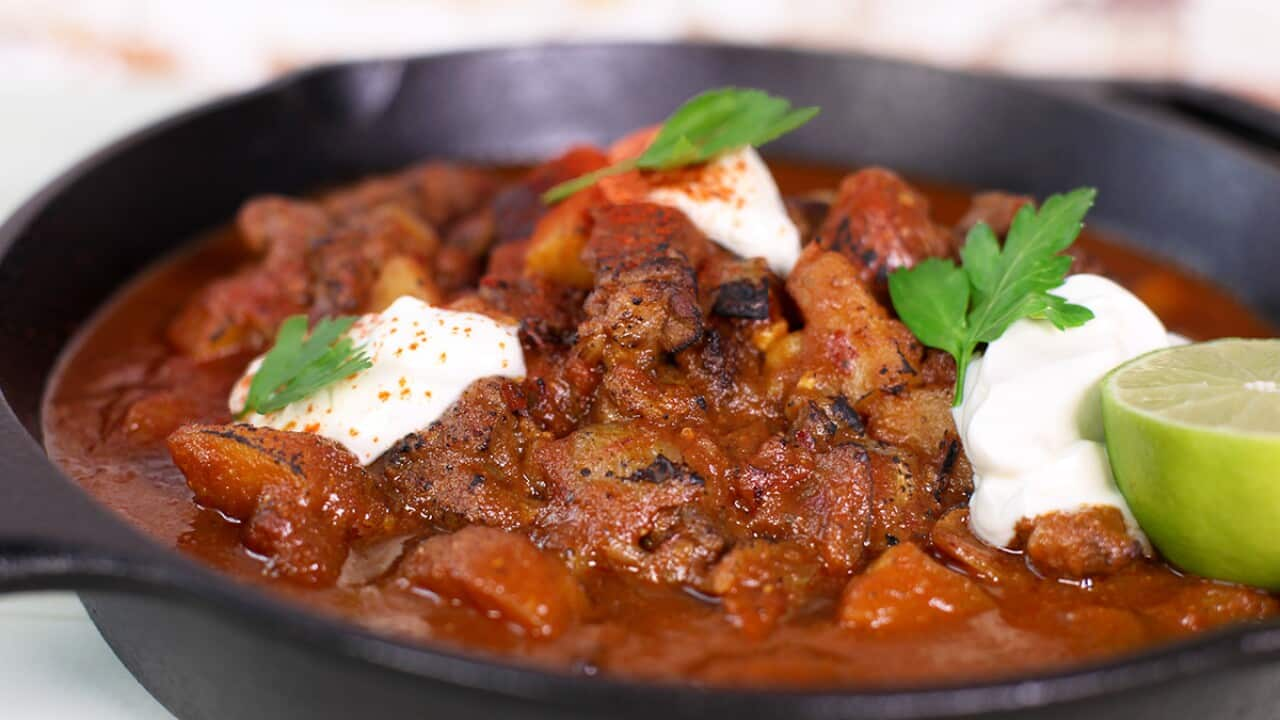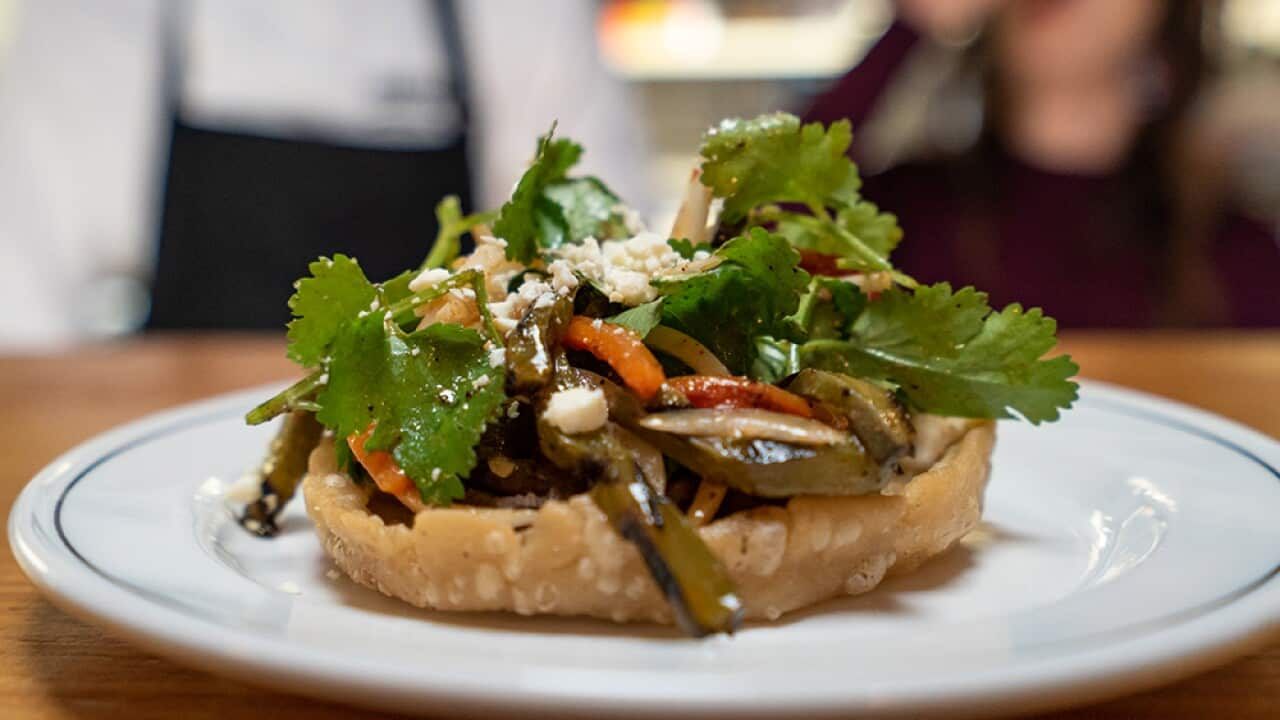As the head chef of Bar Patrón, Axell Torres is on a mission to change the perception of Mexican food in Australia.
"At first, I encountered that it was all about Tex Mex, burritos and tacos, and people think that Mexican food is always spicy, it always has coriander, which it doesn't," the 31-year-old says.
"Also, it is supposed to be cheap and it is nothing that can be well presented, well-executed and made with love and care for the produce."
It's actually one of the most important cuisines in the world.
What he wishes people knew is that it's an ancient cuisine that has UNESCO Intangible Cultural Heritage of Humanity status.
"It's actually one of the most important cuisines in the world," he says.
"The Aztecs, when you come to think about it, they had the corn already so they ate the corn out of the cob but how come they took the kernels of the corn, cook it in limestone, let it sit overnight and then make a flour out of it? It is impressive."
Modern-day Mexican cuisine is an amalgamation of ancient Aztec custom and more recent colonisation.
"The Aztecs were the ones that did the corn and investigation for flour, we wouldn't have any pork unless it was from the Spanish, and the Americans brought cheese," he says.
Regional specialities
While the menu at Bar Patrón has dishes diners expect, such as tacos and quesadillas, Torres is also delighting in regional dinners where he can introduce a new range of flavours. Oaxaca and Veracruz have been on the menu and the Yucatan is next.
"Mexican cuisine is very diverse, there are 31 states and each has their own dishes," he says.
His abuela (grandmother) would cook the dishes she knew, which means Torres grew up eating regional dishes from Oaxaca and that included the famous mole.
There was so much love and care in it.
"In Oaxaca, there are seven different moles, one for each of the seven regions of the state," Torres says. "I love that it's very complicated, there is a lot of care cooking it. It's supposed to be cooked in a clay pot for 30 days.
"I remember my grandmother used to get all the ingredients then she put the barbecue on and start grilling all the chillis and all the spices so it gets a toastiness to the mole negro, then blend everything together to make the paste. She cooks it all day and then let it sit and then cook it the next day. There was so much love and care in it."
His abuela made a living selling pozole, and to this day it's a dish his mother cooks for him every time he goes home.
"Pozole is one of my favourite dishes. It is supposed to be a very thick soup, I could even say it is like the Mexican ramen. The base is grain which is hominy, a big white corn kernel, cooked a long, long, long time until it puffs up until it looks like a flower and a soup made out of pork broth," he says.

When Axell was growing up in Mexico City, his grandmother would continually shoo him out of the kitchen. But his persistence eventually paid off. Source: Bar Patrón
Usually, Mexicans eat it during their Independence Day, on September 15.
There are three main kinds; red, white or green. "White pozole is typically from central Mexico, green pozole is found in Guerrero and red pozole mainly comes from northern Mexico," Torres explains.
"For me, pozole is as traditional as Mexican food can get. It varies in ingredients and base from region to region, but always the same essence: a hearty broth combining meat and a starchy ingredient."

Pork pozole rojo - slow-cooked pork, guajillo/arbol hominy risotto, mizuna, radish, coriander, lime. Source: Bar Patrón
Aussie/Mexican mash-up
While the regional dinners are a great way to introduce diners to new dishes and also work as a testing ground – the green mole from the Oaxaca dinner is going on the main menu – it is also an experiment in combining cultures.
"I try to make it very Mexican and use different Australian produce to try to translate it to people," Torres says.
"For the Oaxaca menu, I made a tetela - a corn dough filled up with beans we cook with an avocado leaf or epazote, which are very traditional Mexican herbs - but I did it with saltbush, a native Australian plant just to try to give it a different flavour, but similar. It was herby, I really liked it.
"From Veracruz, a soup called chilpachola is usually made out of crab but I did it with Moreton Bay bugs."
More about mole
The word mole comes from the Nahuatl (the language spoken by the Aztecs) word molli, which means chilli sauce. It is a dish that's traced back to pre-Columbian times.
Oaxacan moles
- Mole negro: from La Cañada. Black mole gets its colour from burnt tortillas and roasted chillies. It has lots of different nuts, fruits like plantain and raisins, spices such as oregano cinnamon, avocado leaves and cloves.
- Mole rojo: from the coast. It's mainly a red mole and gets its colour not only from the chillies and tomatoes, but from dried prawns that are sometimes used in the sauce.
- Mole verde: green mole from Istmo. This is the only mole made out of purely fresh ingredients, such as tomatillos, jalapeños, pumpkin seed, etc.
- Mole amarillo: yellow mole which gets its name from the chillies and spices used.
- Mole coloradito: from central Mexico. A light but tasty mole.
- Mancha manteles: a sweet and sour, yet spicy sauce, made mainly with fruits and chillies.
- Mole chichilo: more delicate in flavour despite the incorporation of chilhuacle chillies.
HISTORY WITH YOUR FOOD

Mexican braised beef with potatoes (chile verde con carne y papas)












